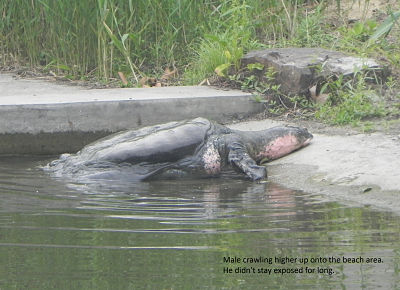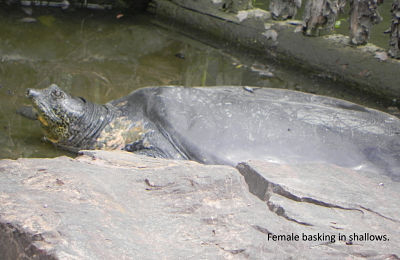Turtle Behavior - More Than Just Basking
by Emily King 
 When people ask me what I do on day to day basis, they’re often surprised to hear that a lot of it is purely observational. I am by the turtle enclosures making notes on their behaviors. The general response is always “How active can turtles be?” But I think the truth will surprise many.
When people ask me what I do on day to day basis, they’re often surprised to hear that a lot of it is purely observational. I am by the turtle enclosures making notes on their behaviors. The general response is always “How active can turtles be?” But I think the truth will surprise many.
A good understanding of animal behavior is an important part of any conservation program. By watching them on a daily basis under various conditions, I can get a sense of what’s normal and what isn’t. Sometimes behavioral changes can signal a change in the overall health of the animal. For example, both animals will come out of brumation around March or April and many people assume they are ravenous at this time and will want to eat constantly. The male does eat fairly regularly early on in the summer but will go off his food later on, when the ambient temperatures get really high. The female is the opposite and doesn’t begin seriously eating until after she’s laid a few clutches of eggs and it’s warmer out (around mid-July). If this were to suddenly change, i.e. the male doesn’t eat early in the season or eats during the periods of extreme heat, it may be a warning sign that something else going on.
 The animal’s behavior is also a good indication of their reproductive status. Each year, prior to nesting, the female spends time watching the beach. After a disturbance (say the keepers have gone in to feed or the grounds crew had to enter the enclosure for whatever reason), the female will swim up to the beach and spend some time looking it over. Even when she’s basking during this time of year, she positions herself so that she can keep one eye on the beach. Then, prior to the actual nesting event, she will crawl onto the beach one evening to do a little bit of recon. Closed circuit TV has revealed that on these occasions, she spends roughly 20-30 minutes on the beach, crawling around and sniffing at the sand. Exactly what environmental signals or cues she’s looking for remain unknown but I know that after this, she’ll more than likely nest within the next 48 hours. This year, she made her first recon of the beach on the evening of June 6th. After that I knew she would nest soon and got all the incubation materials ready. The female did indeed lay her first nest of the season the following night and the zoo staff and I were able to process the eggs and get some of them set up in the incubators (the rest we leave on the beach for natural incubation).
The animal’s behavior is also a good indication of their reproductive status. Each year, prior to nesting, the female spends time watching the beach. After a disturbance (say the keepers have gone in to feed or the grounds crew had to enter the enclosure for whatever reason), the female will swim up to the beach and spend some time looking it over. Even when she’s basking during this time of year, she positions herself so that she can keep one eye on the beach. Then, prior to the actual nesting event, she will crawl onto the beach one evening to do a little bit of recon. Closed circuit TV has revealed that on these occasions, she spends roughly 20-30 minutes on the beach, crawling around and sniffing at the sand. Exactly what environmental signals or cues she’s looking for remain unknown but I know that after this, she’ll more than likely nest within the next 48 hours. This year, she made her first recon of the beach on the evening of June 6th. After that I knew she would nest soon and got all the incubation materials ready. The female did indeed lay her first nest of the season the following night and the zoo staff and I were able to process the eggs and get some of them set up in the incubators (the rest we leave on the beach for natural incubation).
So while turtles may seem like a boring animal to observe, their smallest actions and behaviors can speak volumes and is what makes them fascinating to watch. Even something as seemingly dull as basking is important to understand as changes such as how much time they bask, basking posture, or basking location can mean something more than simply warming up. As the female has laid her first nest of the season and will more than likely lay at least one more, I can once again be found by the pond, watching for those subtle signs that I need to get my second set of incubation boxes ready.
